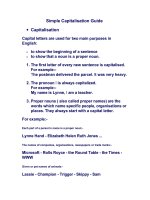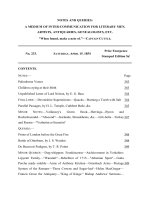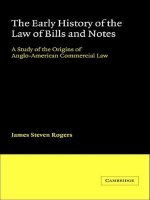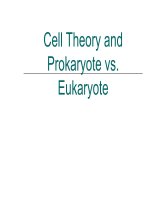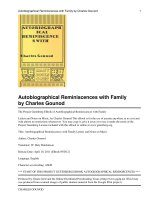- Trang chủ >>
- Đề thi >>
- THPT Quốc Gia
s1013 notes
Bạn đang xem bản rút gọn của tài liệu. Xem và tải ngay bản đầy đủ của tài liệu tại đây (221.48 KB, 3 trang )
STUDY NOTES
EPISODE 13: UNDER THE SEA
DEFINITE AND INDEFINITE ARTICLES
STUDY TIPS
English uses articles to provide information
about a noun, whether it is generic,
indefinite or definite.
To remind you when to use the or
a/an, remember that the belongs to
the group of “th” words – this/these,
that/those – and refers to a
particular or definite person, place
or thing.
Choosing the appropriate article can be
confusing and difficult, especially for those
language learners whose native languages
do not differentiate between definite and
indefinite articles.
a/an belongs to the words meaning
“one” and means an example of
one of something.
These notes cover most of the difficult
situations.
In English there are two types of articles - indefinite and definite.
Indefinite:
a, an
a – used with words and abbreviations that begin with a
consonant, for example a pear, a DVD
an – used with words and abbreviations that begin with a
vowel, for example an apple, an ATM
Definite:
the
No article required: no article (∅).
Generic nouns and articles: a, an or no article (∅).
A generic noun is used for a non-specific reference, making a generalization about
a whole group of people, objects, places or things. It is a kind of symbol that
represents all or any member of an entire group.
USE
Nouns
countable
uncountable
Singular
a, an
A chocolate is sweet and hard.
Meaning: not one actual chocolate
but any one chocolate that
represents all others
∅
Chocolate is a nice desert.
Meaning: all chocolate, generally
Plural
no article (∅)
Chocolates are delicious.
Meaning: all chocolates
are delicious
Page 1 of 3
Indefinite nouns and articles: a and an
An indefinite noun is used to name real people, places or things, but the reference is
unspecified. Indefinite articles are used with singular countable nouns.
SINGULAR COUNTABLE NOUNS
Use
1. to introduce an unknown person,
place or thing into the text for the first
time
2. when the person or thing does not
refer to someone or something
specifically
3. when making reference to a
person’s job or a member of a group
4. when giving a definition
5. in set phrases: a few, a little, a
bottle of, a kilo, a dozen, a lot of etc.
EXAMPLE
I bought a paper from the newsagent on
the corner. It had an article about the
drought.
He took a notebook to class.
He is a teacher.
She is an Australian.
The shark is a carnivorous animal.
Only a few students attended the
workshop on the weekend.
Definite nouns and articles: the
A definite noun is used when naming a person, place or thing specifically.
DEFINITE NOUNS: THE
Use
1. when the reference to the person or
thing is known
2. when it refers to something unique
3. when the noun has been referred to
before
4. when referring to someone’s job
title
5. with a superlative adjective
6. with time periods
7. with proper nouns that have an of
phrase
8. with some geographic names,
specifically referring to a group
9. with names of oceans, seas and
rivers
10. with regions
11. with names of government
departments, organisations
12. with adjectives naming the
nationality of a people
EXAMPLE
The teacher marked our essays in class.
Part time English students are entitled to
use the library facilities.
The sun was bright and almost orange.
They chose a school close to the city.
The school has an excellent reputation.
the chief executive officer
Susan got the highest mark in the
listening test.
the twenty-first century, the winter, the
spring, in the morning, the future
the University of Technology
the Netherlands, the Philippines, the
United Kingdom, the Himalayas
the Nile, the Yangtze, the Atlantic
(Ocean), the Red Sea
the West, the South Pole, the Equator
the Department of Foreign Affairs, the
United Nations
the Australians, the Thais
Page 2 of 3
Pronunciation of Articles
•
the is pronounced /ð / in front of words beginning with a consonant, for
example the Thais /ð 'ta z/.
•
the is pronounced /ði / in front of words beginning with a vowel, for example
the Australians
/ði j s'tre lj n/; when linking between two vowels a /w/ or
/j/ sound is inserted.
•
when stressing the to emphasis the word following, the pronunciation is always
/ði / even before a consonant, for example
The man shouted to the boys, “Put it on the floor, not the table”.
Practise saying these phrases emphasising the and then NOT emphasising
it.
the Antarctic expedition
/
•
j æn'takt k ksp 'd
vs
n/
the Antarctic expedition
/ð j æn'takt k ksp 'd
n/
when stressing a to emphasise the word following, the pronunciation is always
/e /, even before a consonant, for example
Practise emphasising a and then NOT emphasising it in these phrases.
a computer lab tutorial
vs
/e k m'pjut læb tju't ri l/ vs
•
a computer lab tutorial
/ k m'pjut læb tju't ri l/
when a word begins with a silent ‘h’, an an is used before the word, for example
an hour (‘h’ is silent) / n 'a
/
compare:
a harbour
/ 'hab /
Page 3 of 3

